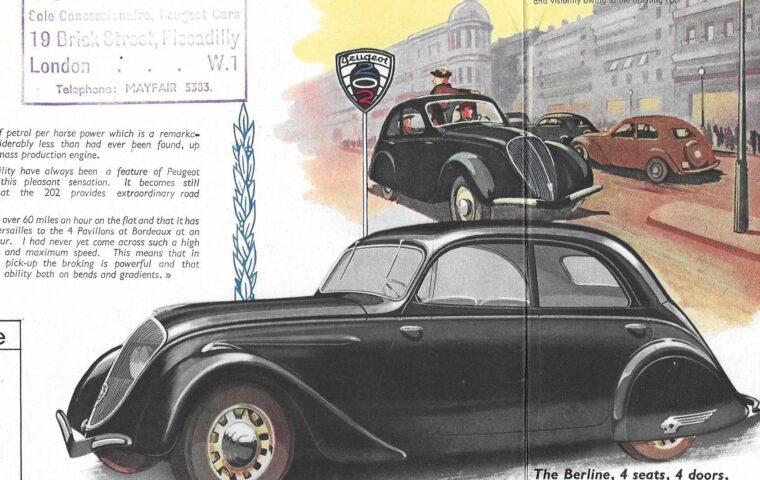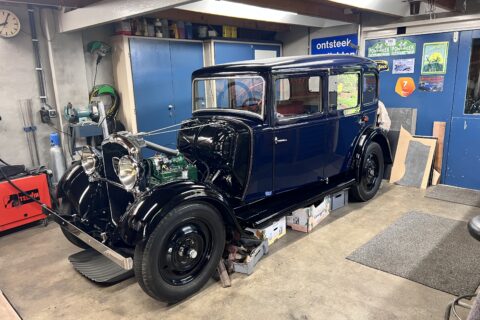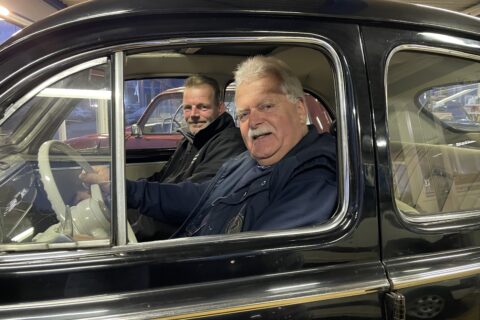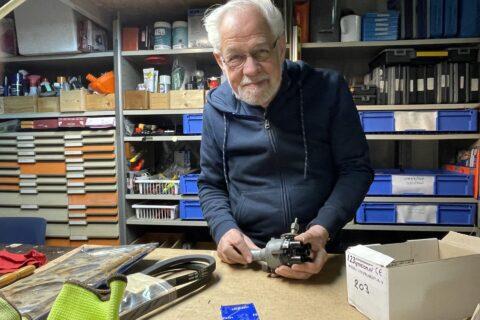Andrew Bannister collects car brochures. That started at a young age and has never stopped. His passion for collecting car brochures is great and has led to a unique collection about brands and models from all over the world. Andy takes us on a journey in the world of cars on the basis through his collecting experiences.
Andrew: “I’ve been collecting brochures since I started in 1977 at the age of 12. With two older brothers who loved cars, I was always interested in them from a very early age, and one day I saw an advert with a tear-off coupon inviting me to send back for a brochure – it was a 1977 one for the VW range, which at that time still included the Beetle.
Getting a package addressed to me through the post was a novelty at the time, and I began to look for other cut-out coupons to send in. Very soon I graduated to writing letters to manufacturers and importers in the UK – I suppose I must have hand-written them in those days, and started trying to get a brochure on every car then on sale. I’d monitor motoring magazines for news about a new model coming out and add that to my list, and I’d soon amassed a few hundred brochures which I spent a long time reading. In those days they had a lot of interesting text and technical information.
One day in school, in a French class, the teacher brought in some copies of the French magazine ‘Paris Match’ and I was entranced to see adverts for cars I was only dimly aware existed because they were not imported into the UK at the time – Autobianchi and Zastava were two examples. I began experimenting with writing to addresses I found in that magazine, and to my surprise they often replied with a brochure or sometimes a whole pack of them.
I also found a wonderful book called ‘World Cars’, published by the Automobile Company of Italy, which listed all the production models sold across the world, and even listed their manufacters and postal addresses. Soon I was writing to companies all round the globe, and again many replied, often in what seemed to be like very far-away countries like Brazil or Australia. I also probed behind the ‘Iron Curtain’ writing to places like Moscow and East Berlin.
After a while I would spend days in the school holidays in the business section of the city library seeking out trade directories for foreign countries, trying to decipher unfamiliar languages to work out the address of some obscure importer. I must have spent quite a lot of my pocket-money on stamps.
Of course, like many other schoolboys, I also went to motor shows in the UK with my parents and collected armfuls of brochures, and sometimes I would pluck up the courage to go into dealer showrooms I walked past – the British Leyland one was a particular favourite as they had a huge choice ranging from the Mini 850 to the Daimler Limousine.
Unlike most schoolboys, I never stopped collecting, and it has stayed with me through my adult life. Gradually I discovered other collectors who I could swap items with, and I evolved a plan to try and backdate by collection, firstly to the 1960s, and eventually hack to the end of the Second World War. I have mostly stuck to this, but a few interesting pre-war items have slipped through the net.
Since sites like Ebay came on the scene it is obviously easier to find and source older brochures from around the world – I try not to pay too much, and often it is ‘pot luck’ in spotting an item. Sometimes rare ones come up and the seller doesn’t really know what they are.
In terms of the vehicles, my parameters are cars and vans (up to the size of a Ford Transit) – I decided not to try and collect heavy truck brochures, or motorbikes. I do include those tiny ‘voiturettes’ made principally in France and Italy, as I find that a fascinating sub-group of often quite bizarre vehicles. Kit cars and specialist vehicles like funeral cars are also in my collection.
In the past, many brochures were printed locally in a particular country by the manufacturer of importer and thus were highly individual in terms of photography and production values – some of them little works of art, others charmingly amateurish. These very individual types are the ones I most enjoy – in later years increasingly they have become almost the same for every market, apart from the language.
At the current time I have around 33,000 brochures and that causes problems in itself as I do not really have sufficient space to store them in an accessible way – ideally at some point I would like to find a new location to house them with more room. Mostly they have to be stored in large plastic boxes, which I categorise by make in most cases.”

What is the story behind your favorite brochure?
“This is a very difficult question – like asking the father of ten children which one is his favourite. Every day of the year I might answer in a different way.
As I have it to hand I will choose an early 1970s brochure on a curious little British three-wheeler car called the Bond Bug. The Bond was made by Reliant, a company which was on the receiving end of many jokes, and I am always fond of the underdog. The car itself is a bright orange wedge and the brochure pictures capture that carefree 1970s sense of fun perfectly.
I also acquired it in a strange way, in my very first job. After studying history at university I wasn’t sure what I wanted to do next and happened to see an advert for a reporter on a small local newspaper in a town fairly near to me. I applied and got it, and to my surprise one of the tasks required of me was to be the motoring correspondent.
I inherited an old filing cabinet full of mostly tattered old press release and press pictures, which was in a terrible state and the editor advised me to throw it all out and start again. From it I rescued a few salvageable old things, including the Bond brochure, which must have been about 15 years old by that time. So it is both an interesting artefact and has happy memories of a job which taught me a lot.”
Do you know other collectors with such a big car brochure collection?
“I do know quite a few collectors – many people do specialise in particular makes of years however, so not so many are ‘generalist’ like me who try and collect everything. I am sure there are people who have more brochures than I do. It is a limitless subject and no-one can ever have a complete set.”
Are there missing pieces in your collection? Brochures that are very difficult to find?
“I am actually more interested in ‘ordinary’ cars than very rare exotic supercars, although of course I will collect those if I can find them. I am therefore not a person to who’s principal ambition is to own a Lamborghini Miura or Ferrari Daytona brochure, as I am not going to shell out hundreds of Euros for a single item.
Latin American brochures are some of my favourites, as often cars there were manufactured years beyond their time and evolved their own unique characteristics. I have a good collection of Brazilian brochures, but I am weaker on the cars of countries like Argentina and Mexico. I have been trying to find more on obscure manufacturers such as Aymesa in Ecuador and Grummet in Uruguay, for example.
There are still some British cars manufactured abroad that I am looking for – the Hillmans of Peru, the Mini-Cord from Venezuela, the BMC cars made in Chile and Argentina, Authi models from Spain and so on. Cars of the former Soviet Bloc also fascinate me and there are many obscurities. More recently, China has a bewildering amount of manufacturers which are very hard to even keep track of.”
Do you have Peugeot brochures and which one is your favorite?
“Brochures from Peugeot’s UK importer for the 1977 model year were among the first I had in my collection and I have always admired them for their simple elegance and for an evolutionary style making them instantly recognisable.
My favourite of all is probably a 504 V6 coupé and convertible brochure from the early 1980s as that was one of the few Peugeot models not to be sold in the UK – I wrote to Peugeot in France to get it. Surprisingly it is actually printed in English, although I’m not sure what market it would have been intended for.
Special editions of models like the 104 and 205 are among my favourites, and I have a soft spot for the 604, surely one of the most elegant European saloon cars of its era.
One of my oldest brochures is one of my few pre-war ones – a UK-market Peugeot 202 folder from 1939, which has charming illustrations and is also rather poignant in view of the dark cloud of war about to envelop Europe.
I also like some of the obscure Peugeot brochures from around the world – more for their curiosity value than their artistic merit – for example a very late model 504 made in Nigeria and a 405 made in Iran.”
Is there anything you like to share with us?
“Being a brochure collector can be quite a lonely hobby as mostly friends and family are rather amused and baffled by such an obsession. About six months ago I started a Twitter account (@addict_car) to experiment with sharing these with other car enthusiasts and historians from around the world, and the response has been a positive. One day I might even have a go at writing a book, as I do honestly believe this is important social history and deserves to be more widely known.”


















